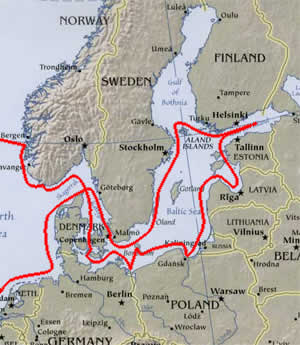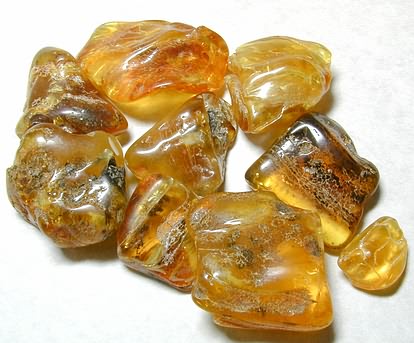Finding amber is his second challenge on behalf of Massalia. But as the scientist that he is, he will search for the sources of the Tanais. The Teutons, Scythia, Scandinavia, Finland… come out of the shadows. He is now thinking about returning.
* The Baltic Sea
We know that he visited the Baltic regions. This is the last part of his contract with Marseille. He is looking for amber. What do the texts tell us? For once Strabo says nothing, except to deny. It is Pliny and Diodorus who inform us. Pliny mentions many islands of the "Gallic Ocean" by citing Pytheas as a source. In another book he gives other details: "Pytheas there is an estuary of the ocean, inhabited by the Guiones, a Germanic people, named Metuonis, six thousand stades long". And then Pomponius Mela: "Beyond the Elbe, the immense Codamus gulf is filled with large and small islands..." A passage from Strabo gives us other indications, even if he does not believe them, as usual: "Because of our ignorance of these regions, those who have told us stories about the mountains of Rhipeae and about the Hyperboreans are considered worthy of serious discussion, and also all the lies of Pytheas the Massaliote about the countries bordering the ocean..."
Pytheas describes an estuary, Metuonis, six thousand stades wide (about 900 km).
Where could it be? It is perhaps, as some authors think, the group of rivers that go from the Scheldt to Denmark. The coasts are flat and dotted with low islands that are undoubtedly covered at high tides. But one can hardly call this region a gulf. So we think this gulf is the Baltic Sea.
 |
Pytheas enters the Baltic Sea in search of amber and the springs of Tanais |
And Strabo tells us the regions of which he is ignorant. The Romans having gone as far as the south of Denmark, it is therefore further that he is ignorant. Thus, the Codamus, an immense gulf, is the Baltic Sea.
The northern islands enter history: Pliny: "There are writers (Pytheas of course)(1) who mention other islands: the Scandinavians, Dumna, the Bergues, and the largest of all Norway, from where one can go by sea to Thule" (P67). and again: "the Codamus, full of islands of which the most famous is Scandinavia, whose dimensions are so large that they could not be determined... And Finland is considered not to be inferior to it..." (P73). This is the first time in history that Scandinavia with two countries (Norway and Finland) are named. But also other islands including the Bergues (Bergen?) which can be navigated to Thule. And also the mysterious peoples that are the Ovones, the Hippopodes, the Panodes (Pliny P73).
The peoples of the north today recognize in Pytheas the man who gave birth to them.
How far did Pytheas go in his quest for the sources of the Tanais? Strabo (O62), claims that he found them. What could this river be? The Vistula, no doubt. What does he do next? What if he tried to reach Asia by the edge of northern Europe? He then goes up the Baltic towards the north, but in vain. He finds no passage.
* Amber
Pliny mentions ninety-six islands in the "Gallic Ocean" There are many nameless islands. One of them is "from Scythia, a day's journey away, where amber is deposited by the spring waves, as Timaeus says ... from Scythia, after three days' journey is an immense island, Balcia. Pytheas calls it Basilia." And this: "From there, the island of Abalus is a day's journey away where is carried by the waves in spring and generated by the frozen sea. The local inhabitants use it like wood and sell it to their Teutonic neighbors. Timaeus also believes (Pytheas) but calls the island Basilia." Amber is found near the Jutland peninsula. But in this region there is no breakup in spring. So it is to the Baltic Sea that Pytheas went. The estuary is probably the group of rivers that flow into the Baltic from the south of the Jutland peninsula to the Vistula (Gulf of Danzig).
 |
Baltic Sea Amber |
Abalus may be the local name for the island. It may come from a Celtic name "apal" which means apple. Pytheas calls it Basilia which means Royal in Greek. Where is it? It is very difficult to answer because in this region, as we have said, the coasts are low and the continent is gradually emerging from the waves following the retreat of the last glaciers. What was an island two thousand three hundred years ago may be a peninsula today? And in addition, there are many of them on the shores of the Baltic. The island of Bornholn, between Poland and Sweden, seems to us to be suitable. What is true is that amber still exists today in these parts. So, in any case, near the Vistula. Greek coins dating from the VI BC have been found in this region. This is proof that there were relations between the Greeks and these regions, but does not mean that they come from Pytheas.
Three amber routes left from there. One towards the Rhine basin, the Rhone and Marseille; the second by the Vistula and the plains of Ukraine towards the Black Sea; the most important by the Vistula towards the Danube, the Alps to end up at the bottom of the Adriatic (Eridan). What Herodotus wanted to ignore.
Now, the time of the second return to Massalia has come.
.

